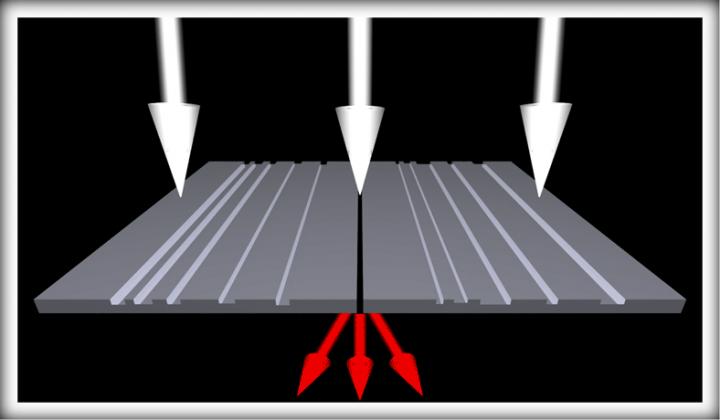Color me purple, or red, or green, or …

Schematic shows two different ways that white light interacts with a newly developed device, a directional color filter ruled with grooves that are not uniformly spaced. When white light illuminates the patterned side of the compact metal device at three different angles -- in this case, 0° degrees, 10° and 20° -- the device transmits light at red, green and blue wavelengths, respectively. When white light incident at any angle illuminates the device from the non-patterned side, it separates the light into the same three colors, and sends off each color in different directions corresponding to the same respective angles. Credit: NIST
Imagine a miniature device that suffuses each room in your house with a different hue of the rainbow–purple for the living room, perhaps, blue for the bedroom, green for the kitchen. A team led by scientists at the National Institute of Standards and Technology (NIST) has, for the first time, developed nanoscale devices that divide incident white light into its component colors based on the direction of illumination, or directs these colors to a predetermined set of output angles.
Viewed from afar, the device, referred to as a directional color filter, resembles a diffraction grating, a flat metal surface containing parallel grooves or slits that split light into different colors. However, unlike a grating, the nanometer-scale grooves etched into the opaque metal film are not periodic–not equally spaced. They are either a set of grooved lines or concentric circles that vary in spacing, much smaller than the wavelength of visible light. These properties shrink the size of the filter and allow it to perform many more functions than a grating can.
For instance, the device's nonuniform, or aperiodic, grid can be tailored to send a particular wavelength of light to any desired location. The filter has several promising applications, including generating closely spaced red, green and blue color pixels for displays, harvesting solar energy, sensing the direction of incoming light and measuring the thickness of ultrathin coatings placed atop the filter.
In addition to selectively filtering incoming white light based on the location of the source, the filter can also operate in a second way. By measuring the spectrum of colors passing through a filter custom-designed to deflect specific wavelengths of light at specific angles, researchers can pinpoint the location of an unknown source of light striking the device. This could be critical to determine if that source, for instance, is a laser aimed at an aircraft.
“Our directional filter, with its aperiodic architecture, can function in many ways that are fundamentally not achievable with a device such as a grating, which has a periodic structure,” said NIST physicist Amit Agrawal. “With this custom-designed device, we are able to manipulate multiple wavelengths of light simultaneously.”
###
Matthew Davis and Wenqi Zhu of NIST and the University of Maryland, along with Agrawal and NIST physicist Henri Lezec, described their work (link is external) in the latest edition of Nature Communications. The work was performed in collaboration with Syracuse University and Nanjing University in China.
The operation of the directional color filter relies on the interaction between the incoming particles of light — photons — and the sea of electrons that floats along the surface of a metal. Photons striking the metal surface create ripples in this electron sea, generating a special type of light wave — plasmons — that has a much smaller wavelength than the original light source.
The design and operation of aperiodic devices are not as intuitive and straightforward as their periodic counterparts. However, Agrawal and his colleagues have developed a simple model for designing these devices. Lead author Matthew Davis explained, “this model allows us to quickly predict the optical response of these aperiodic designs without relying on time-consuming numerical approximation, thereby greatly decreasing the design time so we can focus on device fabrication and testing.”
The work described in the new paper was conducted at NIST's Center for Nanoscale Science and Technology.
Paper: M.S. Davis, W. Zhu, T. Xu, J.K. Lee, H.J. Lezec and A. Agrawal, Aperiodic nanoplasmonic devices for directional colour filtering and sensing. Nature Communications. Published online 7 November 2017. DOI: 10.1038/s41467-017-01268-y
Media Contact
All latest news from the category: Physics and Astronomy
This area deals with the fundamental laws and building blocks of nature and how they interact, the properties and the behavior of matter, and research into space and time and their structures.
innovations-report provides in-depth reports and articles on subjects such as astrophysics, laser technologies, nuclear, quantum, particle and solid-state physics, nanotechnologies, planetary research and findings (Mars, Venus) and developments related to the Hubble Telescope.
Newest articles

First-of-its-kind study uses remote sensing to monitor plastic debris in rivers and lakes
Remote sensing creates a cost-effective solution to monitoring plastic pollution. A first-of-its-kind study from researchers at the University of Minnesota Twin Cities shows how remote sensing can help monitor and…

Laser-based artificial neuron mimics nerve cell functions at lightning speed
With a processing speed a billion times faster than nature, chip-based laser neuron could help advance AI tasks such as pattern recognition and sequence prediction. Researchers have developed a laser-based…

Optimising the processing of plastic waste
Just one look in the yellow bin reveals a colourful jumble of different types of plastic. However, the purer and more uniform plastic waste is, the easier it is to…


